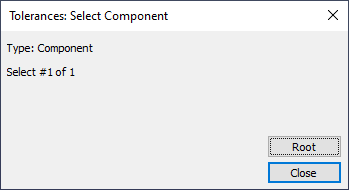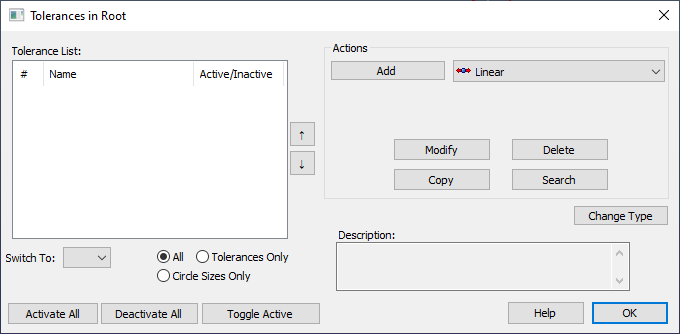3DCS Tolerances are used for applying tolerance directly to DCS Points or Feature Points. Any point with a DCS Tolerance associated to it will deviate according to the Distribution and limits of the tolerance.
Topics about 3DCS Tolerances:Within this Section:About 3DCS Tolerances How to Create a 3DCS Tolerance How to Delete a 3DCS Tolerance How to Copy/Duplicate a 3DCS Tolerance How to Change a Tolerance to a different 3DCS Tolerance type Using Feature Groups in the Tolerance list dialog
|
How to Create a new Tolerance: It is recommended to place a 3DCS Tolerance in the part containing the points to be toleranced.
1.Select the ![]() Tolerance list dialog from the Model Creation toolbar.
Tolerance list dialog from the Model Creation toolbar.

2.Select a part in the Model Navigator or select [Root]. Selecting Root will create the tolerance at the top level assembly. A Tolerance List dialog is displayed. The same dialog can be accessed by double-clicking on the Tolerance List in the Tree window.

3.Select a Tolerance from the list and click on the [Add] button. The Tolerance dialog box is displayed.
4.When finished editing the Tolerance, select [OK] or [Apply]. The Apply button keeps the Tolerance List window open, allowing you to immediately enter another tolerance. OK will save and close the Tolerance dialog box. The Cancel button exits the dialog without saving it and returns you to the Tolerance List window.
5. Click the [Add New] button to add the existing Tolerance and refresh the tolerance dialog to create a new one without having to close and reopen.
6. Users can immediately check the tolerance by setting the model to ![]() Nominal Build and then
Nominal Build and then ![]() Deviate.
Deviate.
How to edit an existing Tolerance:
All the existing tolerances will appear in the Tolerance List in the Model Navigator. Select a tolerance and then right-click in the Tolerance List and select the [Modify Tolerance] button, or double-click on the tolerance in the list.
1.Double-click on the ![]() Tolerance List and select the tolerance and then Modify, or right-click on a tolerance and then select [Modify Tolerance].
Tolerance List and select the tolerance and then Modify, or right-click on a tolerance and then select [Modify Tolerance].
2.Modify the tolerance as required. Click [OK] or [Apply] to apply the changes.
3.Users can immediately check the tolerance by setting the model to ![]() Nominal Build and
Nominal Build and ![]() Deviate.
Deviate.
How to delete a Tolerance:
1.Open the ![]() Tolerance list dialog.
Tolerance list dialog.
2.Select a tolerance in the Tolerance List dialog and press the [Delete] button.
3.Click [OK] in the confirmation window to delete the tolerance. To delete multiple tolerances at the same time, select tolerances by either drag-selecting them from the list, or clicking on each one while holding the Shift or Ctrl key, then press [Delete].
How to copy an Existing Tolerance:
4.Open the ![]() Tolerance list dialog.
Tolerance list dialog.
5.Select a Tolerance and then select [Copy].
a.Right-click on a Tolerance in the Model Navigator and select [Quick Copy]. Quick Copy will copy the tolerance with all customized parameters (Range, Offset, Features, etc.).
b.If copying Tolerances to a new part, right-click on a tolerance in the Model Navigator and select [Copy]. Right-click on the new part and select [Paste].
To Convert a Tolerance from one type to another:
Double-click the Tolerance list and press the [Change Type] button and select the new tolerance type from the list.
Some tolerances require additional information such as vectors and that may need to be manually set. |
Reordering Tolerances in the Tolerance Window:
1.Highlight the tolerance in the Tolerance List to be moved.
2.Select the Switch To: drop-down list arrow, or use the ![]() or
or ![]() arrows, next to the Tolerance list field. One or more Tolerances in the list can be selected and moved in the list.
arrows, next to the Tolerance list field. One or more Tolerances in the list can be selected and moved in the list.
3.Select the index number from the list which you would like the highlighted Tolerance moved to.
4.The highlighted tolerance will move to the place specified by the Switch To index.
Using Feature Groups in the Tolerance list dialog:
Users can add Feature Groups to the Tolerance lists, to allow Tolerances to be stored in a customized list.
•While a Feature Group is active in the Tolerance list dialog, the next created measure will be created in the Feature Group.
•If any Feature Groups exist in the Tolerance list, only the selected Feature Group List will show the available Tolerances.